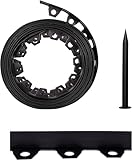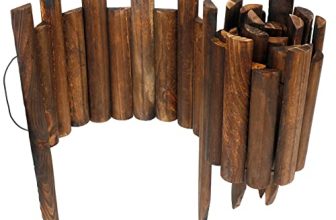Create Neat and Defined Outdoor Spaces with Plastic Lawn Edging Plastic lawn edging is a…
Lawn edging is not only a practical solution for defining boundaries in your outdoor space but also an essential decorative element that transforms your garden into a well-structured landscape. Whether you’re looking to prevent grass from invading flower beds or create a distinct border along pathways, the right edging can enhance the overall appeal of your yard. This comprehensive guide covers everything you need to know about lawn edging—from materials and installation to maintenance and creative design ideas—ensuring your garden remains both attractive and functional throughout the seasons.
Types of Lawn Edging
Choosing the right type of lawn edging is crucial to complementing your landscape’s overall style. Here are some popular options with updated insights:
-
Plastic Edging:
Lightweight and flexible, plastic edging is ideal for DIY enthusiasts. Available in rolls or strips, this material is versatile enough to create curved or straight borders. Recent innovations have made it more durable and UV-resistant, ensuring longevity even under harsh weather conditions. -
Metal Edging:
Metals like steel and aluminum deliver a sleek, modern appearance. Offering durability and a sharp, clean line, metal edging works well in contemporary gardens. Its resistance to weathering makes it perfect for areas with frequent rainfall or frost. -
Stone or Brick Edging:
For a timeless look, natural stone or brick creates a robust border that exudes elegance and permanence. These materials can be arranged in various patterns—from classic straight lines to intricate designs—adding character to both traditional and rustic landscapes. -
Wood Edging:
Made from pressure-treated timber or cedar, wood edging introduces a warm, natural feel. It’s ideal for creating a rustic or cottage garden aesthetic. Modern treatments have increased its lifespan and resistance to decay, making it a viable option for many gardeners. -
Concrete Edging:
Concrete provides a durable, long-lasting solution. Whether pre-cast or poured on-site, it can be stamped or stained to mimic natural stone, giving your yard a polished, high-end finish. Its versatility makes it a popular choice in both urban and rural settings.
Key Considerations Before Installing Lawn Edging
Before diving into your lawn edging project, consider these essential factors:
-
Functionality:
Decide if your primary goal is to separate turf from planting beds, outline pathways, or act as a barrier for mulch and soil retention. -
Aesthetic Style:
Align your edging choice with the overall design of your garden. Whether your style is modern, traditional, or eclectic, select a material that enhances your landscape’s character. -
Maintenance:
Some edging materials require minimal upkeep, while others might need periodic cleaning or resealing. Factor in your time and budget for long-term care. -
Budget:
Costs can vary significantly. Consider not just the material expense but also installation labor and future maintenance costs.
Installation Guide for Lawn Edging
A successful installation ensures that your lawn edging remains effective and visually appealing for years to come. Follow these updated steps:
-
Prepare the Area:
Clear the designated zone by removing existing vegetation, grass, and debris. A clean work area is crucial for precision. -
Mark the Border:
Use stakes and string to outline your intended border. Whether you plan for gentle curves or sharp lines, precise marking is key. -
Dig the Trench:
Depending on the material, dig a trench 4 to 8 inches deep. This depth will vary according to whether you’re using plastic, metal, stone, or concrete. -
Install the Edging Material:
Follow the manufacturer’s guidelines. Secure plastic or metal edging with anchors, while heavier materials like stone might require a solid base of gravel. -
Backfill and Secure:
Fill the trench with soil or gravel to stabilize the edging. Make sure the installation is firm and level. -
Add Finishing Touches:
Enhance the border with decorative mulch, gravel, or stones for a refined finish that complements your garden’s style.
Pros and Cons of Lawn Edging
Evaluating the benefits and drawbacks of various edging solutions can help you make an informed decision:
Pros:
-
Enhanced Definition:
A well-installed border keeps your lawn, garden beds, and walkways neatly separated. -
Aesthetic Appeal:
It creates a structured look that boosts your yard’s visual appeal and curb value. -
Low Maintenance:
Effective edging can reduce the need for frequent weeding and trimming. -
Versatility:
With numerous materials available, you can choose a solution that suits your style and environmental conditions.
Cons:
-
Installation Challenges:
Some materials may require professional installation or specialized tools. -
Maintenance Requirements:
Depending on the material, ongoing care such as resealing or repair might be necessary. -
Cost Variability:
The initial and long-term costs can vary, especially for high-end materials like natural stone. -
Design Limitations:
Once installed, certain types of edging may restrict future landscape modifications.
Usage Tips for Lawn Edging
Maximize the functionality and beauty of your lawn edging with these expert tips:
-
Select the Appropriate Material:
Evaluate your garden’s climate, soil conditions, and overall style before deciding on a material. For instance, areas prone to heavy rain might benefit from metal or concrete options. -
Plan Your Layout Thoroughly:
Consider the overall garden design, including curves, corners, and transitions. A thoughtful layout ensures a cohesive look. -
Follow Manufacturer Guidelines:
Always adhere to installation instructions to ensure durability and proper alignment. -
Regular Maintenance:
Keep the edging clear of debris and check periodically for signs of wear or damage. -
Incorporate Design Elements:
Enhance your border with natural stones, decorative gravel, or even integrated lighting for an added visual impact.
Reviews, Prices, Coupons, and Discounts
Before purchasing your edging materials, it’s important to conduct thorough research. Consider these points:
-
Research Multiple Options:
Read product reviews and compare different materials to understand their performance over time. -
Evaluate Price Comparisons:
Look at various retailers and online stores. Occasionally, promotional discounts or coupons may be available. -
Return and Warranty Policies:
Ensure that your purchase is covered by a satisfactory return policy and warranty to safeguard against defects. -
User Feedback:
Customer testimonials can provide real-world insights into the longevity and performance of the edging material.
Choosing the Right Lawn Edging
When selecting the perfect lawn edging solution, weigh the following factors:
-
Material Durability:
Consider how the material will perform under your local climate conditions, including exposure to rain, frost, or intense sun. -
Aesthetic Compatibility:
Your edging should complement the natural features of your garden and enhance its overall appeal. -
Ease of Installation:
For DIY projects, opt for materials that are user-friendly and require minimal specialized tools. -
Long-term Maintenance:
Think about how much effort you’re willing to invest in upkeep. Some materials require regular attention, while others are virtually maintenance-free.
Caring for It
To ensure your lawn edging remains in pristine condition, follow these care guidelines:
-
Regular Cleaning:
Remove debris, weeds, and dirt buildup periodically to maintain a neat appearance. -
Routine Inspections:
Check for any signs of damage like cracks, rust, or shifting. Early detection can prevent costly repairs later. -
Prompt Repairs:
Address any issues immediately. Whether it’s re-securing a loose section or resealing a crack, prompt action extends the life of your edging. -
Protective Treatments:
Consider applying sealants or protective coatings to materials like wood or concrete. This helps guard against UV damage and moisture intrusion.
Frequently Asked Questions
Q1: What are the best materials for installing lawn edging?
A: The optimal material depends on your garden’s style and environmental conditions. Popular choices include plastic for ease, metal for durability, natural stone or brick for elegance, wood for a rustic look, and concrete for long-term performance.
Q2: How deep should the trench be for lawn edging installation?
A: Generally, a trench should be 4 to 6 inches deep for plastic and metal options, while stone or concrete edging may require a 6 to 8-inch depth for added stability.
Q3: Can I install lawn edging on uneven or sloped terrain?
A: Yes, many edging materials are designed to accommodate uneven surfaces. Flexible options such as certain plastics or segmented metal systems are ideal for sloped or irregular areas.
Q4: What maintenance does lawn edging typically require?
A: Maintenance varies by material. Regular cleaning, periodic inspections, and timely repairs are key. Wood may need resealing, while metal might require rust prevention measures.
Q5: Where can I find inspiration for creative lawn edging designs?
A: Explore gardening blogs, the Royal Horticultural Society website, and local garden clubs for innovative ideas and expert advice on enhancing your outdoor space.
Conclusion
Lawn edging is a versatile landscaping solution that not only defines the boundaries of your garden but also adds significant visual appeal. Whether you’re opting for a modern metal finish, the natural charm of stone, or the ease of plastic, the right edging transforms your outdoor space into a cohesive and stylish environment. By carefully considering material durability, installation techniques, and long-term maintenance, you can achieve a stunning garden border that elevates your home’s curb appeal and functionality.
Embrace the benefits of smart garden design with these updated tips and ideas. With thoughtful planning and regular upkeep, your lawn edging will remain a timeless asset, enhancing both the beauty and practicality of your landscape for years to come.


![10m Lawn Edging Borders,Plastic Garden Edging Border [Extra Tall 10cm]with 50pcs Stakes, Flexible Landscape Edging Kit Mini Fence for Path Yard Flower Beds Pavement-Black](https://m.media-amazon.com/images/I/41Wc2HZKyTL._SL160_.jpg)





















![Flexible Garden Edging Border 10m,Garden Borders[Extra Tall 10cm High] Landscape Edging Mini Plastic Fence with 30pcs Stakes,Lawn Edging Kit No Dig for Yard Flowerbeds,Grass-Black](https://choicemart.co.uk/wp-content/uploads/2025/02/flexiblegardenedgingborder10mgardenbordersextratall10cmhigh-336x220.jpg)
